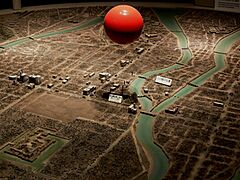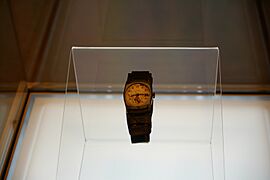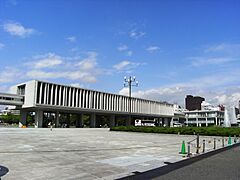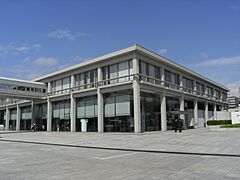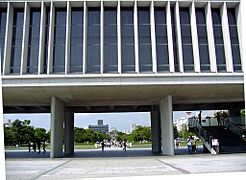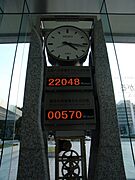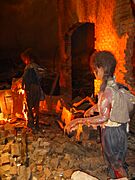Hiroshima Peace Memorial Museum facts for kids
 |
|
| Lua error in Module:Location_map at line 420: attempt to index field 'wikibase' (a nil value). | |
| Established | 1955 Remodeled 1991 Renovated Peace Memorial Hall 1994 Renovated 2019 |
|---|---|
| Location | 1-2 Nakajima-chō, Naka-ku, Hiroshima, Japan |
| Type | Peace museum |
The Hiroshima Peace Memorial Museum is a special place in Hiroshima, Japan. It's part of the Hiroshima Peace Memorial Park. This museum teaches everyone about the atomic bombing of Hiroshima that happened during World War II.
The museum first opened in August 1955. It quickly became a very popular spot for school trips from all over Japan. Many visitors from other countries also come to learn here. Between 1955 and 2005, over 53 million people visited the museum. That's more than one million visitors every year!
Contents
What You Can See at the Museum
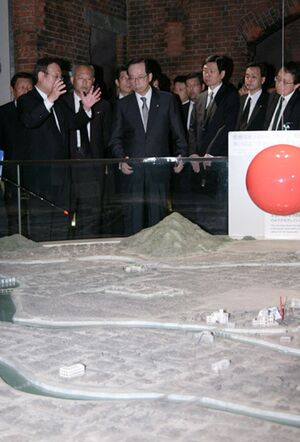
The Hiroshima Peace Memorial Museum collects and shows many items. These include belongings left by people who were affected by the atomic bomb. There are also photos and other materials that help explain the terrible event.
The museum also shows what Hiroshima was like before and after the bombing. It talks about the world today and the dangers of nuclear weapons. Every item on display tells a story of sadness, anger, or pain from real people. Hiroshima hopes that by sharing these stories, all nuclear weapons will be removed from the world. The city wishes for a truly peaceful international community.
Learning About the Bombing
To help people learn, the museum was updated in 1994. It was split into two main parts. The East Wing, which was the newest part, showed the history of Hiroshima City before the bomb. It also explained how the bomb was developed and why the decision was made to drop it. This section also covered what life was like for people in Hiroshima during and after World War II. It talked about the nuclear age and efforts to achieve peace around the world.
The East Wing used to have a model that showed how much damage the city suffered. It also displayed important letters between scientists and leaders about atomic weapons.
The Impact of the Atomic Bomb
The West Wing of the museum focused on the terrible damage caused by the bomb. One section, called Material Witness, showed clothes, watches, hair, and other personal items from the victims. Another part, Damage by the Heat Rays, showed how intense heat affected wood, stone, metal, glass, and even human skin.
The section Damage by the Blast explained the destruction from the powerful explosion. Finally, Damage by the Radiation detailed the health problems people faced because of the radiation.
Recent Updates to the Museum
The museum started big renovations in 2014. The East Wing reopened in 2017 with new, interactive displays. The old city model was replaced with a new one that uses projection mapping. This new model shows the effects of the bomb blast in a more engaging way.
After the East Wing reopened, the Main Hall was closed for safety updates until April 25, 2019. During this time, the exhibits were also updated. They now focus even more on the personal belongings of the victims. The museum's exhibits are now organized into four main sections:
- An introduction in the East Wing.
- "Reality of the Atomic Bombing" and a gallery in the Main Building.
- "Dangers of Nuclear Weapons" in the East Wing.
- "Hiroshima History" in the East Wing.
Images for kids
-
Hiroshima Peace Memorial Museum showing axis with cenotaph and A-bomb dome (1949)
Related Topics
- Atomic bombings of Hiroshima and Nagasaki
- Hiroshima Peace Memorial
- Nagasaki Atomic Bomb Museum
- Sadako Sasaki
- Human Shadow Etched in Stone - a famous exhibit at the museum


